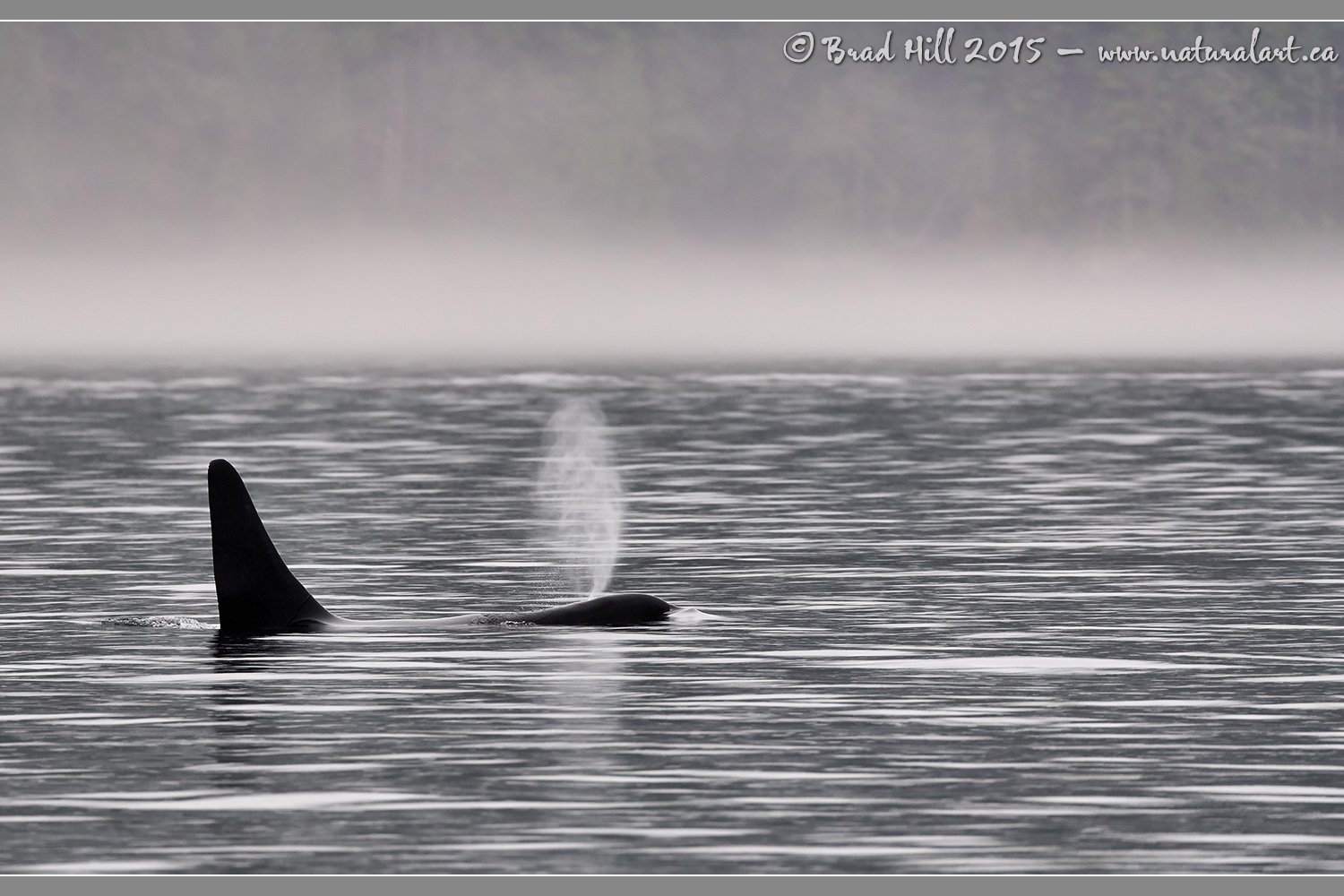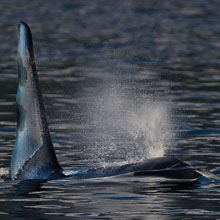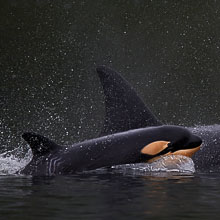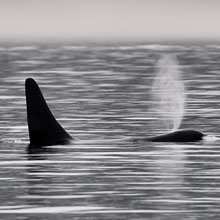Availability: Undetermined - Enquiries?
In the Field
Vapours. Johnstone Strait Region, Vancouver Island, BC, Canada. August 8, 2015.
I love photographing wildlife in overcast, foggy and misty conditions. Which, given I spend a pretty good chunk of time shooting images on BC's central and northern coast, is probably a darned good thing! I love the mood that fog and misty conditions can impart on a scene. And, the low-contrast scenes that foggy days give us can be a real challenge to both capture and process effectively. On the capture end of the image-creation process, I find that you have to look for natural instances of contrast (or contrast gradients) to make most foggy images work. In this case a strong degree of natural contrast was provided by the surfacing Killer Whale.
On the post-processing end of the equation, with foggy shots you have to remain aware of the fact that our cameras tend to totally "flatten out" the contrast that actually IS in the shot. It is EXCEPTIONALLY easy to produce a LOT of very boring low-contrast foggy shots in a hurry! Having the post-processing skills needed to bring back the contrast that existed in the original scene (which often means knowing how to selectively "tease apart" small tonal differences in the raw file) is crucial in making foggy shots "work".
In this shot I captured an adult female Orca (AKA Killer Whale) that's a member of the Northern Resident population just as it began its exhalation (its "blow") as its head broke the surface. If you look closely you can see the small "standing wave" in front of the head produced by forward movement of the whale. I loved the natural monochromatic nature of this scene - there's no B&W conversion "tricks" going on here - just a minor decrease in colour saturation during post-processing. The background forest contained slightly more colour, but even that was muted by the fog.
I'm well aware that foggy, moody shots aren't everyone's cup of tea. Some like bright, vibrant, sunlit shots (which I jokingly refer to as "happy shots") - it's definitely an "each to their own" kind of thing. But given the choice, I'll take foggy scenes over sunny conditions any day of the week!
Here's a higher-resolution (2400-pixel) version of moody shot for your perusal and downloading pleasure:
• Vapours: Download 2400 pixel image (JPEG: 1.2 MB)
ADDITIONAL NOTES:
1. This image - in all resolutions - is protected by copyright. I'm fine with personal uses of it (including use as desktop backgrounds or screensavers on your own computer), but unauthorized commercial use of the image is prohibited by law. Thanks in advance for respecting my copyright!
2. Like all wildlife photographs on this website, this image was captured following the strict ethical guidelines described in The Wildlife FIRST! Principles of Photographer Conduct. I encourage all wildlife photographers to always put the welfare of their subjects above the value of their photographs.
3. This image was captured during my "Humpback, Orcas, Sea Lions & More" photo tour in August of 2015. Each year I offer trips into two different parts of the Great Bear Rainforest as well as one to photograph aquatic mammals and oceanscapes near the northern tip of Vancouver Island. And, in selected years, I also offer photo tours to locations to capture other highly sought-after subjects, such as various owl species of the boreal forest and wildlife of Canada's Arctic. Details about these trips can be found on the Photo Tours page of this website.
Behind the Camera
Vapours. Johnstone Strait Region, Vancouver Island, BC, Canada. August 8, 2015.
Digital Capture; Compressed RAW (NEF) 14-bit format; ISO 900.
Nikon D750 paired with Sigma Sport 150-600mm zoom lens @ 500mm. Hand-held from sailboat. Optical Stabilization on and in "OS1" mode.
1/800s @ f7.1; No compensation from "recommended" matrix-metered exposure setting.
At the Computer
Vapours. Johnstone Strait Region, Vancouver Island, BC, Canada. August 8, 2015.
RAW Conversion to 16-bit TIFF using Phase One's Capture One Pro 8. Adjustments during raw conversion included a levels adjustment, selective contrast adjustment (using a selectively modified tone curve), and clarity adjustment.
Further digital corrections on resulting 16-bit TIFF files using Adobe's Photoshop CC 2015 and Light Crafts Lightzone. Photoshop adjustments included colour saturation adjustments, minor exposure tweaks, and final selective sharpening for web output. Final tone-tweaking performed using LightZone's "tonemapper" tool.
Conservation
Vapours. Johnstone Strait Region, Vancouver Island, BC, Canada. August 8, 2015.
Ten percent of the revenue generated by this image will be donated to Raincoast.
Species Status in Canada*: Endangered - Northeast Pacific southern resident population; Threatened - Northeast Pacific transient population and the Northeast Pacific northern resident population; Special Concern - Northeast Pacific offshore population.
Killer Whales (Orcinus orca) have an extremely high profile in modern pop culture and have become the "poster child" of a number of conservation groups. In most areas where Killer Whales are found they show a remarkable ability to adapt to a variety of habitats - they are found in all oceans, in water ranging in temperature from below 0 Celsius to almost hot tropical waters, and will occasionally even spend significant amounts of time in brackish water or even rivers.
Because the population sizes of Killer Whales are very low and because they have a very low reproductive rate, they face immediate risk from human-related environmental disturbances, including the immunotoxic effects of toxic chemicals we pour into the oceans and to reduction in prey availability (such as salmon).
For more information on the status of Killer Whales in Canada, go to: http://www.speciesatrisk.gc.ca and search under "Killer Whale".
*as determined by COSEWIC: The Committee on the Status of Endangered Wildlife in Canada

























